THE AMERICAN TAXI—A CENTURY OF SERVICE
THE
FOLLOWING ARTICLE CONSISTS OF EXCERPTS FROM THE BOOK
"THE AMERICAN TAXI" BY KEN MERKEL & CHRIS MONIER

The
American Taxi has been providing a vital service for 100 years ! Enjoy
the Taxi experience through the photographs and the history of famous
marques such as Yellow, General, Checker, DeSoto, Packard, Plymouth,
and Studebaker.
Many
minor makes are also represented with forgotten names like Rockwell,
Hupmobile, Overland, Darracq, and Bauer. Oddball experiments, unusual
taxis, lights, meters, and taxi memorabilia are highlighted. A walk
through time illustrates the effect of regulations on taxis that led
to technical advances and body changes.
The
motorized taxicab can trace its recorded ancestry back to about 4,000
B.C. when Egyptian boats carried persons up and down the Nile River,
presumably for an agreed upon fee. In Roman times, hired chariots kept
track of distances traveled with small stones dropped every so many
paces.
More
recently, during the 17th century, specialized horse drawn conveyances,
known as hackney coaches, appeared in Paris and London to transport
the upper crust of society around these growing urban centers.

The
passenger in this turn of the century electric taxi of
unknown manufacture demonstrates the huge disparity in social status
between drivers and their generally well to do passengers. Not only
was there no physical sharing of the same area but, also, the operator
had to sit up on top, exposed to the elements. About the only plus for
the driver was that the relatively pampered fare arrived at accidents
sooner. The taxi used a chain to rotate the front wheels. By 1910, with
advancements in gasoline techologies, electrics were on the way out.
The typical coach was a two passenger vehicle pulled by two horses.
Like today, cabbies frequently waited for passengers at stands situated
outside of transporation centers and major hotels .
The
American hansom cabs became electric with the introduction of the Electrobats
in Philadelphia in 1896 and in Manhattan the following year. Top speed
was about 15 mph and cruising range was limited by the battery technology
of the time. Almost 10 years would pass before the gasoline engine had
improved enough to surpass the electrics.
A
New Yorker named Harry N. Allen coined the word "taxicab"
when he introduced 65 new, French Darracqs, each equipped with a meter,
onto the streets of Manhattan in 1907.
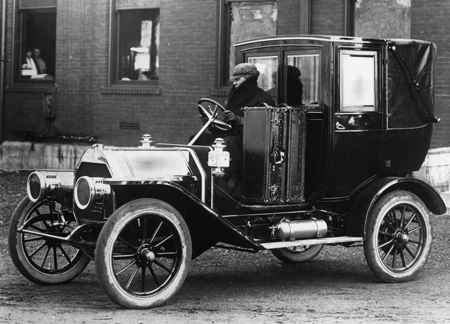
A
1909 Overland Model 31 taxi with collapsible rear roof section was priced
out at a fairly hefty $1,500 with a four cylinder motor rated at 30
horsepower. Several items of interest include the steamer trunk on the
driver's left. On a hard right turn, it looks as if there was nothing
holding it in place except the driver's quick reflexes. An acetylene
tank on the running board provided fuel for the headlights. All of the
shades were pulled down in the rear compartment so that the passenger
could travel incognito.

A
proud, uniformed driver posed with his Los Angleles Yellow Cab, Number
101, in 1926. Mounted in the right front luggage area was a very large
Ohmer meter that printed a receipt. Perhaps the driver wasn't aware
or didn't care that Number 101 had bald tires.
As
the 20th century progressed, more and more automakers got into the cab
manufacturing business since it was pretty much a wide open field and
anybody could play. In January 1924, Chicago hosted the first ever taxi
exhibit show with Reo, Mogul Checker , Willys Knight, Overland, Premier,
Pennant, Dodge, Rauch & Lang, and Roamer taxis all represented,
some with elaborate displays showing cut away cars. In New York City
from 1925 to 1928, there were no fewer than 25 different brands of taxis
operating compared to the two heavy hitters found there today.

The
Paramount taxi was another M.P.Moller Motor Car Company creation and
its life span was probably the same as the Five Boros: 1927 to 1931.
Power was produced by a six cylinder motor and its family resemblence
to the Five Boros wasn't coincidental. Moller taxis frequently picked
up the name of the taxi company that ordered them. For operators it
was classy to have a cab with your company name as the brand. This Paramount
is wearing Manhattan rates not only on the cowl but also on a metal
roof sign just behind the convertible top opening. Whether ordered in
town car or sedan configuration, any Paramount taxi was impressive.

New
York City received 600 1927 Yellow Model 06 taxis like this one out
a total production run of 2,598 units. As was typical for Manhattan,
the cab was built without a right front door and the floor was given
some ribs to minimize luggage movement. The outward apprearance of the
body was quite close to that of a Buick and even the engine was a Buick
six cylinder combined with a three speed transmission. Headlights moved
from the cowl to the front of the car this year and four wheel brakes
were standard for $2,450. The taxi medallion was on the cowl just below
the rates.

One
of Checker Manufacturing's most dramatic cabs came out this year for
a two season run: The Model M. Powered by a Buda six cylinder engine,
these taxis were offered in two wheelbases, a regular six window sedan
or a long model for train station runs. With the acquisition of Parmelee
Tranportation in late 1929, Checker took control of about 7,500 cars,
trucks, and buses used to ferry railroad passengers and freight between
terminals. This restored Model M is the only known survivor in roadworthy
condition.
For
cab drivers, the evolution of the taxi during the 1930s brought an end
to their choice of blue skies or not as the open front town car taxicabs
quietly disappeard by the end of the decade. While these grand machines
were extremely impressive, by 1935 they truly appeared to be from another
era as streamlined, new cars with stamped steel bodies came to dominate
the avenues and city streets.
In
addition, these new vehicles weren't as easy to modify as the old wood
framed ones had been. For all new brands, power was up under the hood
and synchronized transmissions replaced the non-synchronized, "crashbox"
units, which required a lot of double clutching to avoid gear clashing.
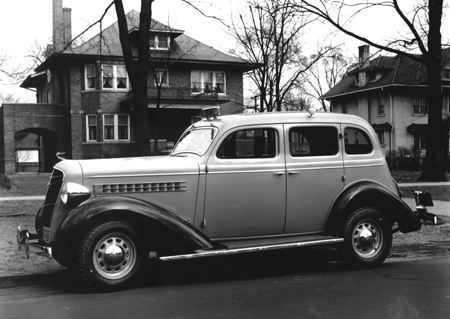
The
DeSoto Airstream was a very competent taxi and developed a loyal follwing
from coast to coast. Like its competitors, a bucket seat and partition
were regular options so luggage or packages could ride up front when
no trunk was specified. It is highly probable that a trunkback sedan
was also available with the taxi package. The taxi roof light was modern
for its day and the conical sidelights over the rear doors were meter
lights. An L head six cylinder that boasted 93 horsepower coupled to
a three speed transmission powered the 3,000 lb. sedan. The Airstream's
larger sibling, the Airflow, saw limited use as a taxicab.

For
the first time in a long time, Checker Cab Manufacturing didn't have
a town car in their lineup. One reason for its demise was that few cabbies
drove with the convertible top open. Checker's solution was the new,
1935 Model Y with an optional air vent over the driver and an extra
cost, glass sunroof, called the Air-N-Lite, in the rear. This restored
1936 example, wearing Parmelee System decals, sports both of those options.
Only two Model Y's are known to exist today. This one is owned by Checker
Motors and resides at the Gilmore Museum in Hickory Corners, MIchigan
and one unrestored example, that had been cut down into a tow truck
by a cab company, is awaiting restoration out West.

Toye
Brothers Yellow Cab in New Orleans, Louisiana, ordered up some of the
last Generals in 1938. 1937 was a mediocre year for General production
with around 442 coming out of the GM truck plant. 1938 was even worse
with only 387. Because of the all the work required to build these specialized
cabs, from splicing bodies and fabricating doors, it wasn't working
out. This General Model 0-18 had the optional Chevrolet name plates.
Toye Brothers had been in the transportation business since 1852 and
they liked to promote that their Yellow Cabs were instantly available
at all hotels, train stations, and 50 convenient sub-stations around
the New Orleans area and that all of their cabs had a privacy partition.

After
World War II, most taxi fleets were clamoring for new equipment and,
as the new cabs slowly trickled in, all brands of prewar cabs suddenly
became so-much-a-pound scrap or you could buy one to drive away for
$15 to $30. After five long years of being nursed well past their prime,
these Checkers from Pittsburg Yellow Cabs were spent. The hand operated
spotlights mounted at the top of the left front roof post were a Pittsburg
Yellow trademark for years and graced their Checkers until the last
ones were retired around 1988.

While
this 1940 DeSoto Skyview and the S.Klein-on-the-Square Annex Clothing
Store in the backround are long gone, this is what the area next to
Union Square in Manhattan used to look like in the early 1940s. The
DeSoto wore a large, comprehensive bumper guard and was showing off
one of the Skyview roof lights. The top part of the sign read "DeSoto"
and the larger, lower half read "Skyview". The four globes
around the sign were decorative. The taxi medallion was still found
on the lower cowl. Under the hood, all large DeSotos were powered by
a six cylinder flathead motor putting out 105 horsepower. About 2,323
DeSoto Skyviews were constructed this year, almost double the number
of civilian seven passenger bodies built.
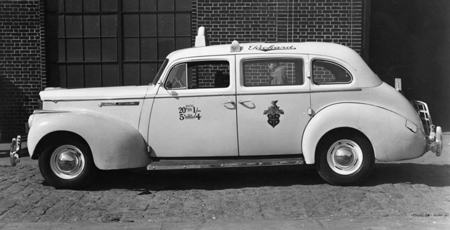
For
the New York City market, Packard took it upscale. Packard took a "One-Sixty"
seven passenger sedan and stripped it down with "One-Ten"
trim to minimize unwanted chrome for a vehicle that everybody knew was
going to get banged up in traffic. The 3,950 lb cab was , appropriately
enough, called the New York Taxi and it featured all the goodies required
by law: trunk rack, license plate up on the trunklid, and five-in-the-rear
seating with privacy partition. A sunroof was installed over the leather
trimmed rear comparment and a Packard crest decal looked sharp on the
rear doors. Even though this body style normally had an eight cylinder
engine, a six cylinder flathead moved this taxi feast around town although
the eight's larger radiator and other heavy duty features were retained
to help the overworked six cope under severe conditions. It is currently
unknown how many of these New York taxis were produced in 1941 and 1942.
None are thought to exist today.
America's
entry into World War II was a nightmare for taxi operators, as they
could no longer buy new equipment after 1942. The rationing of gasoline
and endless recapping of tires was compounded by a chronic shortage
of spare parts that kept broken taxis off the street with no replacements
available.
To
complete the misery index, ridership went up while the supply of taxis
went down because many factories and military bases were humming 24
hours a day and people needed to get to them. By 1945, most of the taxis
in the US were a mess. By estimates of the time, it was figured that
about a quarter of the nation's taxis were in the shop on any given
day.

A
DeSoto Skyview with a sunroof poses on a Manhattan street. The Gates
Service Corporation operated it and their logo on the rear doors was
a whitewall tire sitting above some wings. The interior had the bucket
seat and partition as required by law and the front bumper guards are
noteworthy since they wrap around the corners. Dealer and meter shops
normally installed aftermarket bumper guards. This Gates DeSoto may
not be around today but the Optimo Cigar Company is still serving New
Yorkers.

Another
A6 Chicago Checker Cab shows off the green and ivory paint colors still
used today. A bucket seat and partition still comprised the most common
A6 inteior configuration but change was afoot and within a few years
it would all be different.
Pressure
has been building for years to allow regular production line vehicles
to be used as taxis in places like New York City. The final moment came
on July 16, 1954, when the city approved Chevrolet, Ford, Plymouth,
and Dodge four door sedans for use as taxis in a ceremony at the Hack
Bureau.
The
new "small" taxis were a huge leap forward in terms of drivability
and driver comfort with the addition of such taxi novelties as fully
automatic transmission, power steering, and brakes in a car with 30%
less bulk and a cheaper price tag. By the late 1950s, the list of approved
vehicles for taxi service in Manhattan had expanded to included such
fresh faces as Rambler, Studebaker, Mercury, Buick, and even a few Mercedes.
A
new size niche was created in 1962 when Chevrolet introduced its mid-sized
Chevy II taxi to counteract Ford's new threat, the smaller Fairline
taxi. However, it was still too early to introduce these new smaller
taxi vehicles as most American cab operators hadn't caught the downsizing
bug yet.
Intermediate
cabs wouldn't really catch on until Chrysler introduced the right combination
of room, economy, and low cost with the 1965 Plymouth Belvedere and
Dodge Coronet taxis. The bulletproof 225-ci slant six motor was married
to the rugged 727 Torqueflite automatic in a six passenger car that
weighed less than 3,200 lbs.

A
New Yorker stepped out of a 1960 Ford Fairlane taxi and demonstrated
how the chrome door handle was useful in exiting a modern cab. For the
elderly, obese, or handicapped, new sedans from General Motors, Ford
and Chrysler weren't easy to get in and out of. When equipped with a
partition, modest legroom became downright skimpy. Since Detroit sunk
the floors into the frame to lower the rooflines, the transmission tunnel
and doorsills became higher, creating problems for the less limber.
Ford's Expanded Taxi Package included the chrome door handle on the
right rear door, assist straps on the center doorposts, and full rubber
flooring all around. Ford persisted with the 223-ci overhead valve six
cylinder motor and most cabbies ordered it. The plastic roof domes on
both this 1960 Ford and the 1960 Ford and Chevrolet in the left lane
are typical for this time period in Manhattan. The lack of a partition
was a momentary phenomenon, as they would be back in a few years. No
factory built 1960 Ford Fairlane taxis are known to exist today.

Dodge's
1964 Series 330 taxi was a popular fleet cab for all the right reasons.
It was roomy with a huge trunk and, at a lengh of 209 inches, it wasn't
too large on the outside. Compared to the 224 inch long DeSoto battleships
from 10 years earlier, the new Dodges were like speedboats. As was normal,
most Series 330 taxis came with one of the most legendary powertrains
in cab history: the 225-ci slant six coupled to the optional Torqueflite
automatic. After a couple years of creative styling from Chrysler, the
1964 Dodges became more mainstream.
The
gas crunch of the 1970s saw a move towards smaller taxis like the Plymouth
Volare, Ford Granada and Chevrolet Chevelle. This was bad news for big
cab makers like Checker and sales gradually dropped to the point where
it was no longer viable to keep the classic cab in production.
In
1982, Checker's last year as a carmaker, only 2,000 of the boxy cabs
were produced. In 1989 Chrysler discontinued their last front engined,
rear wheel drive taxis, the Plymouth Gran Fury and Dodge Diplomat followed
by GM's decision to kill off the large Caprice Classic, a very popular
taxi, in 1996. This left Ford as the last traditional taxi maker in
the US.
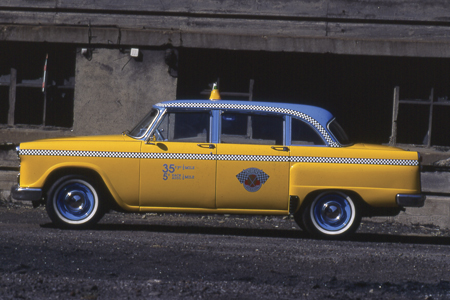
A
1965 Checker illustrates one of the possible paint schemes that could
have existed in New York City until 1968 when a new law made all medallion
cabs yellow. If not for this law, Manhattan would have multicolored
fleets like Chicago. Checker Model A11's, introduced in mid-1962, were
little changed from the previous A9's except for a curved bumper and
turn signals under the headlights instead of in the grill. Powering
most Checkers this year was the 230-ci Chevrolet six with an optional
282 V8. Transmission options included a Borg Warner automatic or a three
speed manual transmission on the steering column or on the floor. This
car is a private Marathon turned into a cab since there are hardly any
real 1965 Checker A11's left. It was normal practice for taxi companies
to search out privately owned Checker Marathons to turn into taxis since
they were essentially the same as an A11 cab except for trim differences
like exterior chrome, carpeting and different dashboard.

Checker
Motors was one of the few auto companies who could keep using the same
basic sales brochures for years since their cars didn't change much.
This 1979 Checker Model A11 ad shows a 1976 or 1977 Checker cab with
the windshield wipers meeting in the middle. In 1978, this was changed
to where they both went in the same direction.

Fritz
Cajuste, medallion number 7A70, was one of the last Checker drivers
in New York City and his ride, a 1981 Checker A11, was typical of an
owner operator vehicle.It had stripes top and bottom, no partition,
and he had replaced the stock Checker seat with one out of a luxury
car. The "Checker Special" decals on the rear doors cost $13.50
for the pair. The silver trimalong the fender openings were added by
a body shop. Fritz Cajuste passed away in the late 1990's but his cab
is still around.
Where
the American taxi will go from here is up in the air. Certainly, minivans,
SUVs , and smaller sedans like the Chevrolet Impala and the Ford Five
Hundred can take up where the classic cabs left off but there is no
question that some of the old timers left big shoes to fill. Whether
the taxis of the current century will be more interesting than those
of the last century remains to be seen.
This
article is published by courtesy of Iconografix, Inc.
All rights reserved.
Copyright 2006, Iconographix, Inc., Hudson, Wisconsin
The
American Taxi - A Century of Service by Ben Merkel and Chris Monier
is available through:
Oldee Taxi Instruments
(718) 482-6533
http://www.taxidepot.com/servlet/Detail?no=49
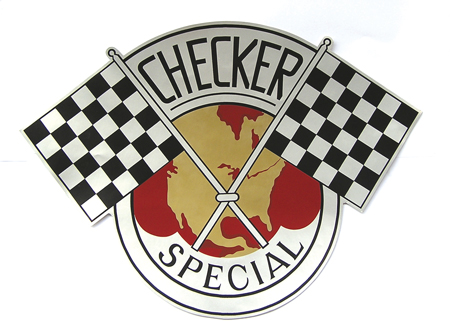
© 2015 TLC Magazine Online, Inc. |




















